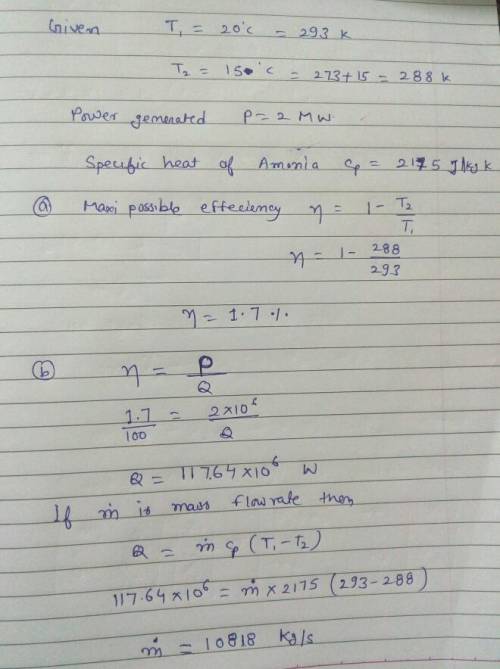
Engineering, 06.05.2020 01:58 lovvyDovvy04
An ocean thermal energy conversion (OTEC) system is being proposed for electric power generation using a Rankine cycle with ammonia as the working fluid. The system is to be used in a location where the oceanic water temperature near the surface is approximately 20oC, while the temperature at a reasonable depth below the surface is approximately 15oC. Consider a power plant that is to generate 2 MW of electricity. For the specified conditions determine the:
(a) Maximum possible thermal efficiency for this cycle if the ammonia enters the turbine as a saturated vapor.
(b) Mass flow rate of ammonia through the system.

Answers: 1


Another question on Engineering

Engineering, 03.07.2019 15:10
If you were designing a bumper for a car, would you prefer it to exhibit elastic or plastic deformation? why? consider the functions of a bumper in both a minor "fender-bender" and a major collision.
Answers: 1

Engineering, 04.07.2019 18:20
Avolume of 2.65 m3 of air in a rigid, insulated container fitted with a paddle wheel is initially at 264 k, 5.6 bar. the air receives 432 kj by work from the paddle wheel. assuming the ideal gas model with cv = 0.71 kj/kg • k, determine for the air the amount of entropy produced, in kj/k
Answers: 2

Engineering, 04.07.2019 19:10
Estimate the change in specific internal energy au and specific enthalpy h from inlet to outlet for ethylene glycol (a liquid) flowing through each of the following devices: (a) a heat exchanger where the glycol temperature increases from 20 °c to 80 °c; (b) a pump operating at about 25 °c and increasing the glycol pressure from 100 kpa to 8 mpa.
Answers: 2

Engineering, 04.07.2019 19:20
To save energy, the air supply to a 2000 ft office has been shut off overnight and the room temperature has dropped to 40°f. in the morning, the thermostat is reset to 70°f and warm air at 120 f begins to flov in at 200ft'/min. the air is well mixed within the room, and an equal mass flow of air at room temperature (changing with time) is withdrawn through a return duct. the air pressure is nearly 1 atm everywhere. ignoring heat transfer with the surroundings and kinetic and potential energy effects, estimate how long it takes for the room temperature to reach 70°f. plot the room temperature as a function of time.
Answers: 1
You know the right answer?
An ocean thermal energy conversion (OTEC) system is being proposed for electric power generation usi...
Questions

History, 24.05.2020 07:57


Mathematics, 24.05.2020 07:57

Mathematics, 24.05.2020 07:57

Spanish, 24.05.2020 07:57

Mathematics, 24.05.2020 07:57



Biology, 24.05.2020 07:57


Mathematics, 24.05.2020 07:57



History, 24.05.2020 07:57



Mathematics, 24.05.2020 07:57

Mathematics, 24.05.2020 07:57

Mathematics, 24.05.2020 07:57

Mathematics, 24.05.2020 07:57




